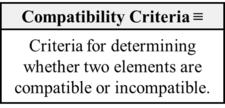Compatibility Criteria
What is compatibility criteria? How should it be defined?
It is necessary to define compatibility criteria in order to understand the method of any scientific community. The definition of method suggests that it can consist of different criteria for theory assessment. The question is how compatibility criteria are different from other criteria of theory evaluation. Thus, it is a key concept in current Scientonomy.
In the scientonomic context, this term was first used by Hakob Barseghyan in 2015. The term is currently accepted by Scientonomy community.
In Scientonomy, the accepted definition of the term is:
- Criteria for determining whether two elements are compatible or incompatible.
Contents
Scientonomic History
Acceptance Record of the Term
| Community | Accepted From | Acceptance Indicators | Still Accepted | Accepted Until | Rejection Indicators |
|---|---|---|---|---|---|
| Scientonomy | 1 January 2016 | Yes |
All Definitions
| Theory | Formulation | Formulated In |
|---|---|---|
| Compatibility Criteria (Barseghyan-2015) | Criteria for determining whether two theories are compatible or incompatible. | 2015 |
| Compatibility Criteria (Fraser-Sarwar-2018) | Criteria for determining whether two elements are compatible or incompatible. | 2018 |
Accepted Definitions
| Community | Theory | Formulation | Accepted From | Accepted Until |
|---|---|---|---|---|
| Scientonomy | Compatibility Criteria (Barseghyan-2015) | Criteria for determining whether two theories are compatible or incompatible. | 1 January 2016 | 11 October 2020 |
| Scientonomy | Compatibility Criteria (Fraser-Sarwar-2018) | Criteria for determining whether two elements are compatible or incompatible. | 11 October 2020 |
Suggested Modifications
| Modification | Community | Date Suggested | Summary | Date Assessed | Verdict | Verdict Rationale |
|---|---|---|---|---|---|---|
| Sciento-2018-0017 | Scientonomy | 28 December 2018 | Accept the new definition of compatibility criteria as criteria for determining whether two elements are compatible or incompatible. | 11 October 2020 | Accepted | The discussions concerning this modification took place mostly online, but primarily outside of this encyclopedia. There is a communal agreement that the modification is to be accepted as it fixes "an obvious drawback of [Barseghyan's] original definition".c1 Since "compatibility is a stance that can be taken towards methods, theories, and questions alike"c2 it is agreed that we need a definition that is applicable to all epistemic elements, not merely theories. It was also noted that the new definition has the advantage of being "neutral to the the addition of new epistemic elements to the scientonomic ontology".c3 |
Current Definition
In Scientonomy, the accepted definition of the term is Compatibility Criteria (Fraser-Sarwar-2018).
Compatibility Criteria (Fraser-Sarwar-2018) states: "Criteria for determining whether two elements are compatible or incompatible."
Like demarcation and acceptance criteria, compatibility criteria can be part of an epistemic agent's employed method. An epistemic agent employs these criteria to determine whether two elements (e.g. methods, theories, questions) are mutually compatible or incompatible, i.e. whether they can be simultaneously part of the agent's mosaic. In principle, these criteria can be employed to determine the compatibility of elements present in the mosaic, as well as those outside of it (e.g. scientists often think about whether a proposed theory is compatible with the theories actually accepted at the time). Fraser and Sarwar point out that Barseghyan's original definition of the term "excludes a simple point that is assumed elsewhere in scientonomy: elements other than theories (i.e. methods and questions) may be compatible or incompatible with other elements (which, again, need not be theories)".1p. 72 To fix this omission, Fraser and Sarwar "suggest that the word ‘theories’ be changed to ‘elements’ to account for the fact that the compatibility criteria apply to theories, methods, and questions alike".1p. 72
Different communities can have different compatibility criteria. While some communities may opt to employ the logical law of noncontradiction as their criterion of compatibility, other communities may be more tolerant towards logical inconsistencies. According to Barseghyan, the fact that these days scientists "often simultaneously accept theories which strictly speaking logically contradict each other is a good indication that the actual criteria of compatibility employed by the scientific community might be quite different from the classical logical law of noncontradiction".2p. 11 For example, this is apparent in the case of general relativity vs. quantum physics where both theories are accepted as the best available descriptions of their respective domains (i.e. they are considered compatible), but are known to be in conflict when applied simultaneously to such objects as black holes.
Ontology
Existence
In Scientonomy, it is currently accepted that "There is such a thing as a compatibility criteria."
Subtypes
In Scientonomy, there are currently no accepted subtypes of Compatibility Criteria.
Supertypes
In Scientonomy, there are currently no accepted supertypes of Compatibility Criteria.
Associations
In Scientonomy, the following association of Compatibility Criteria is currently accepted:
- A compatibility criterion is always part of some method.
Disjointness
In Scientonomy, no classes are currently accepted as disjoint with Compatibility Criteria.
If a question concerning the ontology of a compatibility criteria is missing, please add it here.
Dynamics
If a question concerning the dynamics of a compatibility criteria is missing, please add it here.
Related Topics
This term is also related to the following topic(s):
References
- a b Fraser, Patrick and Sarwar, Ameer. (2018) A Compatibility Law and the Classification of Theory Change. Scientonomy 2, 67-82. Retrieved from https://scientojournal.com/index.php/scientonomy/article/view/31278.
- ^ Barseghyan, Hakob. (2015) The Laws of Scientific Change. Springer.
